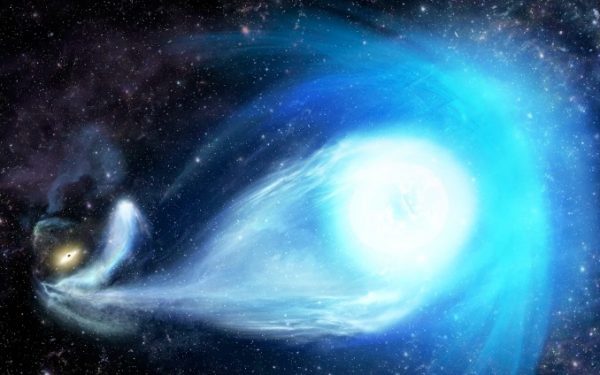Milky Way’s central black hole flings star out of galaxy – Astronomy Now Online

Five million years ago, a binary star system wandered too close to the supermassive black hole lurking at the core of the Milky Way. The hole’s ferocious gravity likely captured one of the stars, but the other was flung away with a velocity of more than 6 million kilometres per hour (3.7 million mph).
That’s fast enough to escape the Milky Way, but even so, it will still take the outward-bound star, known as S5-HVS1, some 100 million years to pass through the galaxy’s outskirts and into the great void of intergalactic space.
“We traced this star’s journey back to the centre of our galaxy, which is pretty exciting,” said Gary Da Costa, an astronomer at the Australian National University. “This star is travelling at record-breaking speed, 10 times faster than most stars in the Milky Way, including our Sun.
“In astronomical terms, the star will be leaving our galaxy fairly soon and it will likely travel through the emptiness of intergalactic space for eternity. It’s great to be able to confirm a 30-year-old prediction that stars can be flung out of a galaxy by the supermassive black hole at its centre.”
Using the 3.9-metre Anglo-Australian Telescope at Sliding Spring Observatory, an international team spotted the star by accident while searching for remnants of small galaxies orbiting the Milky Way.
“The star is only 29,000 light years away, quite close by galactic standards, which means the team could measure its trajectory very precisely,” said ANU’s Dougal Mackey.
The black hole at the heart of the Milky Way, known as Sagittarius A*, has the mass of four million Suns. ANU astronomer Thomas Nordlander said if a binary system gets too close to such a massive object, “the black hole can capture one of the stars into a close orbit and kick out the other at very high speed.”
The process is known as the Hills Mechanism, proposed three decades ago by astronomer Jack Hills.
“This is super exciting, as we have long suspected that black holes can eject stars with very high velocities,” said Sergey Koposov, an astronomer with the Carnegie Mellon University working with the Southern Stellar Stream Spectroscopic Survey. “However, we never had an unambiguous association of such a fast star with the galactic center.
“We think the black hole ejected the star with a speed of thousands of kilometres per second about five million years ago. This ejection happened at the time when humanity’s ancestors were just learning to walk on two feet.”
Ting Li from Carnegie Observatories and Princeton University, leader of the observations of S5-HVS1, said the the star’s trajectory is the first “clear demonstration’ of the Hills Mechanism in action.
“Seeing this star is really amazing as we know it must have formed in the galactic center, a place very different to our local environment,” he said. “It is a visitor from a strange land.”
The research is published in Monthly Notices of the Royal Astronomical Society.





